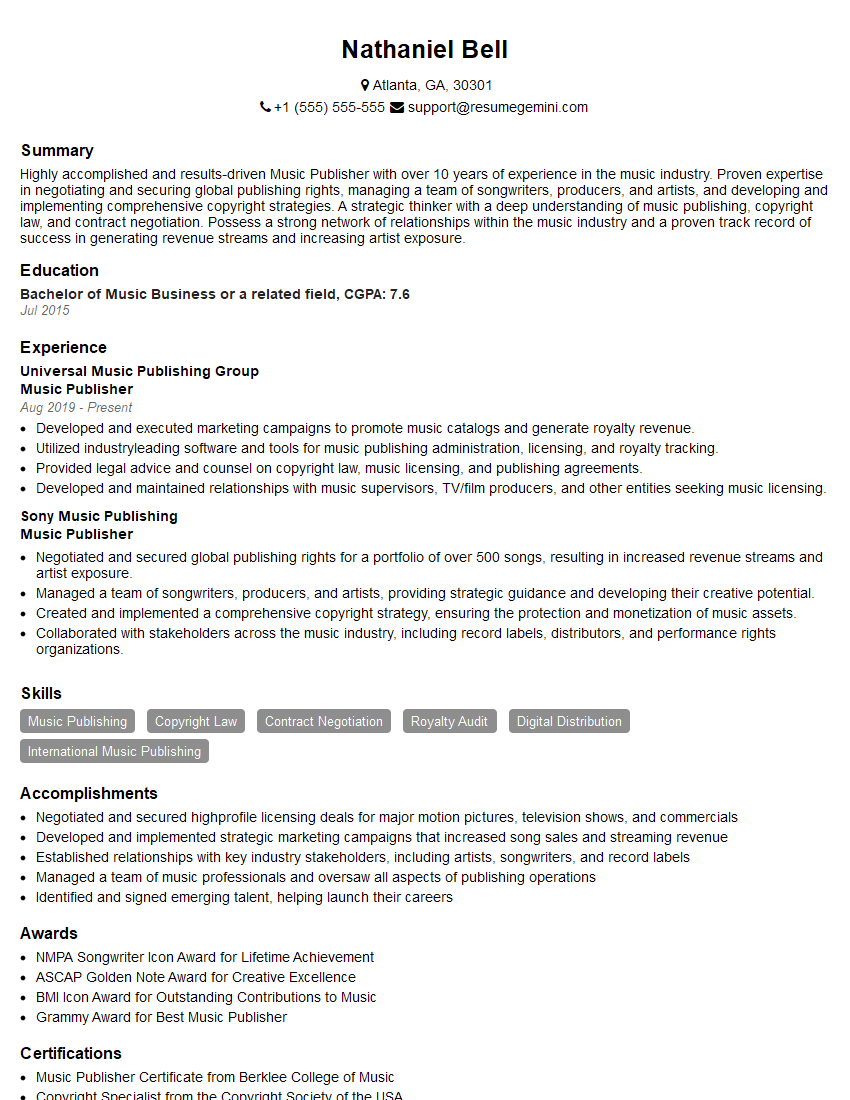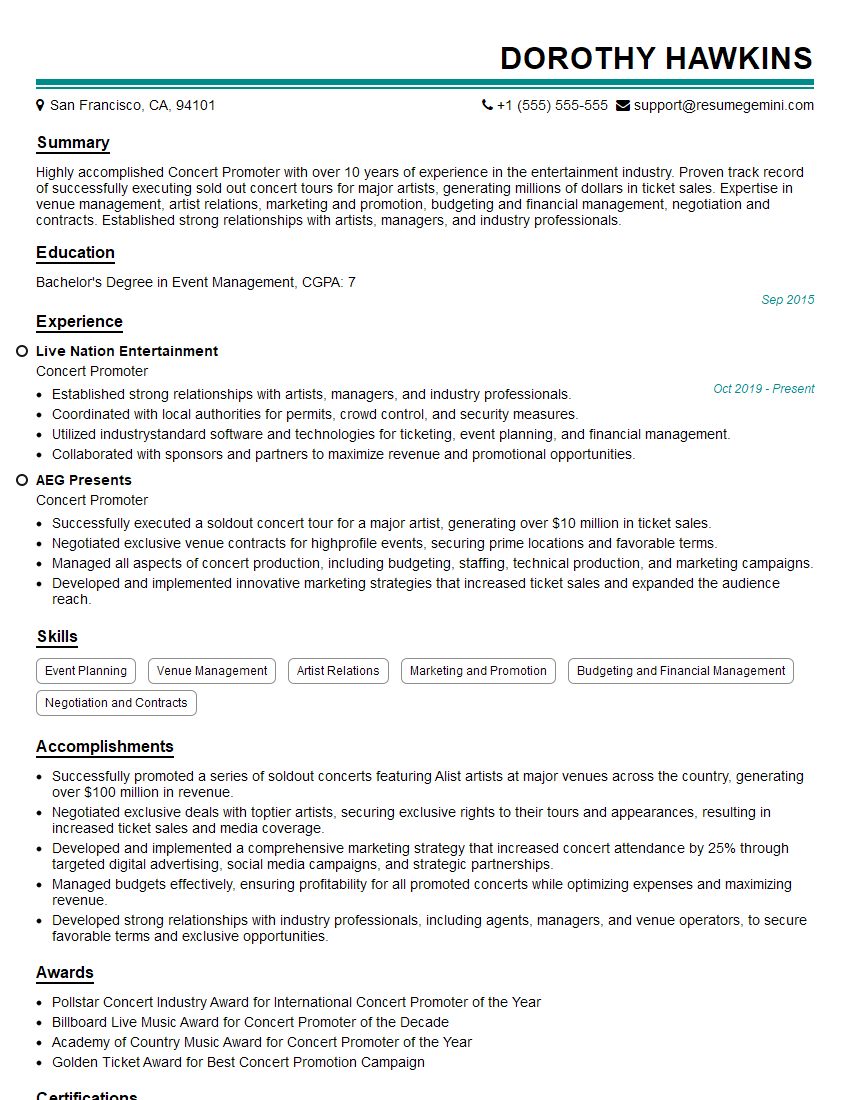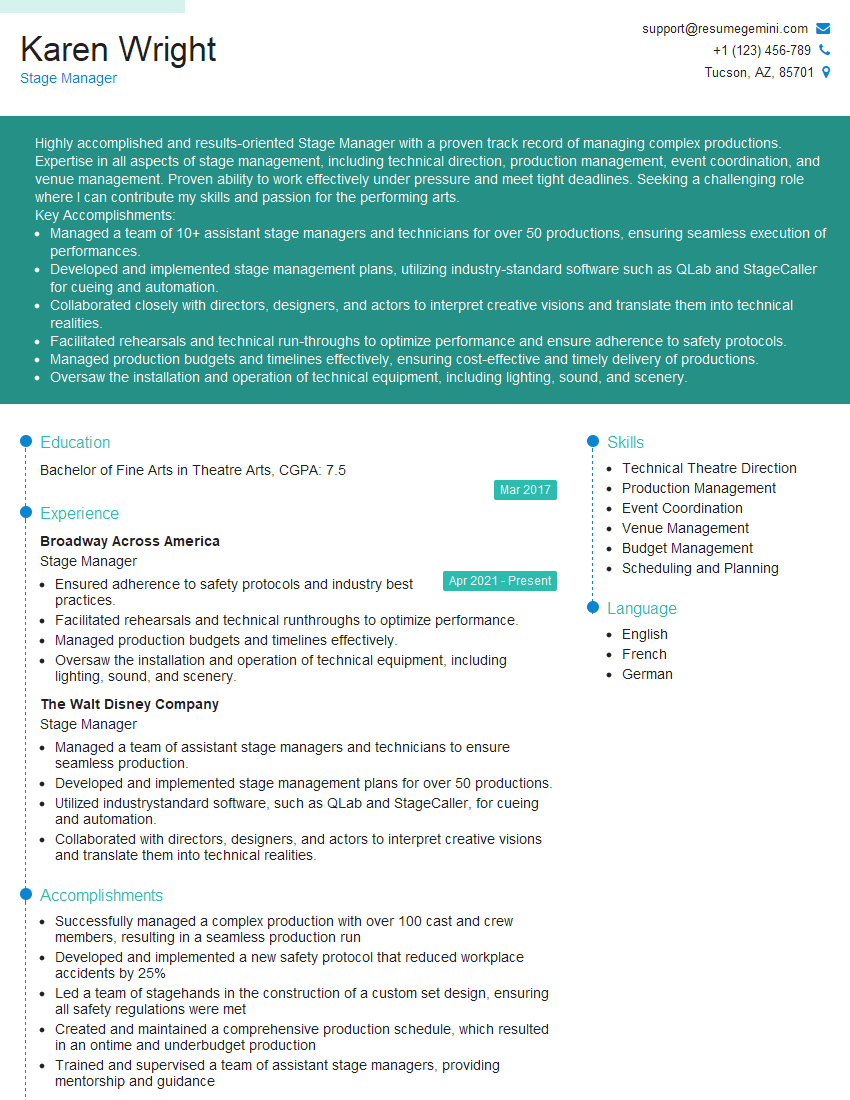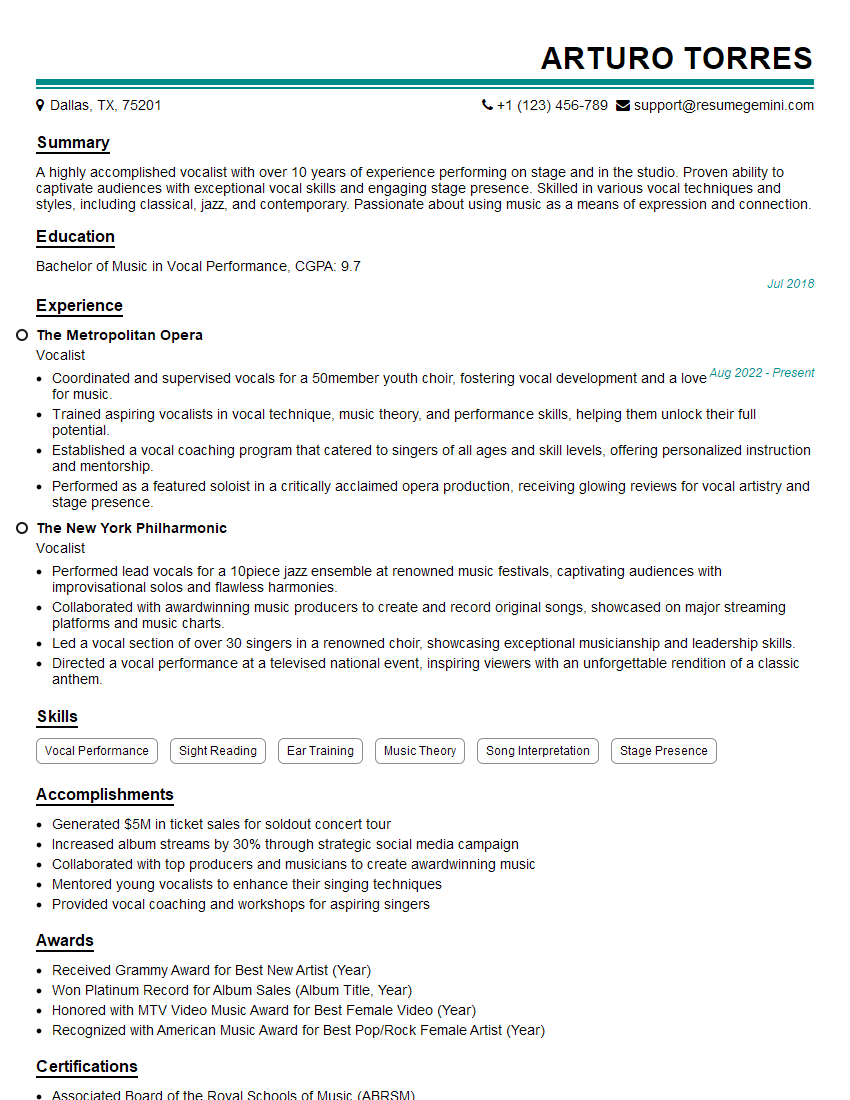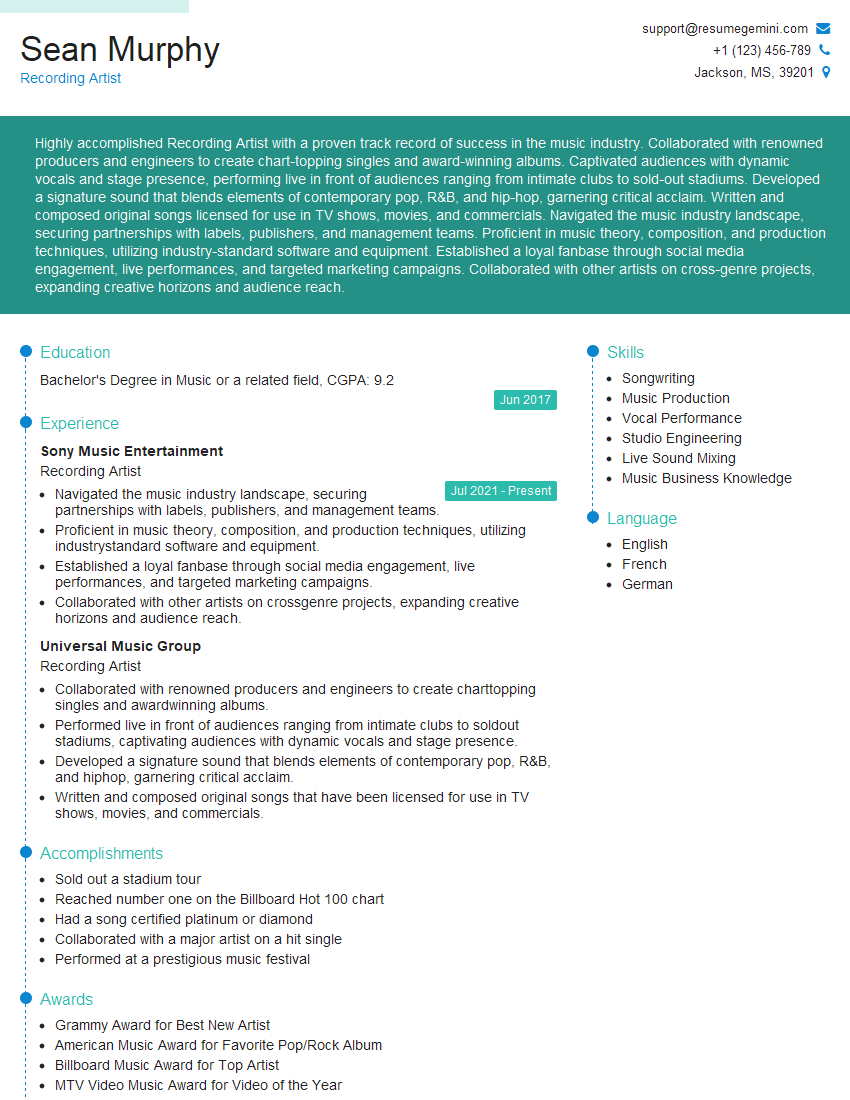Interviews are more than just a Q&A session—they’re a chance to prove your worth. This blog dives into essential Pop Singing interview questions and expert tips to help you align your answers with what hiring managers are looking for. Start preparing to shine!
Questions Asked in Pop Singing Interview
Q 1. Describe your vocal range and tessitura.
My vocal range comfortably spans from a low A2 to a high C6, though I can extend slightly beyond that with specific vocal exercises. My tessitura, however, the range where I sing most easily and consistently, lies between D3 and G5. This is the area where my voice naturally resonates and feels most comfortable, allowing for optimal control and expression. Think of it like this: my full range is like a piano keyboard – I can play all the notes, but my tessitura is the section of the keyboard I play most beautifully and effortlessly.
Understanding your tessitura is crucial. For instance, a song written outside my tessitura might require more effort and technique to achieve a natural sound; pushing beyond it can lead to vocal strain. Conversely, staying within my tessitura allows for a relaxed and controlled vocal performance.
Q 2. What vocal techniques do you employ for breath control?
Breath control is the foundation of good singing, and I employ several techniques. Diaphragmatic breathing, or breathing from the diaphragm, is paramount. I visualize expanding my abdomen as I inhale, filling my lungs from the bottom up. This allows for a steady, controlled release of air, which is essential for sustaining notes and delivering powerful vocals. I also utilize breath support exercises, involving holding sustained notes on different pitches to build strength and endurance.
Furthermore, I practice appoggio, a technique that combines breath support with postural alignment. Maintaining proper posture helps optimize airflow and prevent tension, which is key to prolonged singing. Think of it like a well-tuned instrument – good posture ensures the air flows freely and efficiently.
Regular practice helps refine these techniques. I frequently incorporate exercises such as sustained vowel sounds and scales to build strength and control in my breathing.
Q 3. Explain your approach to microphone technique.
Microphone technique is crucial for projecting my voice effectively and ensuring clear audio reproduction. I maintain a consistent distance from the microphone, usually around 6 to 12 inches, avoiding popping sounds by slightly angling the microphone away from my mouth. This distance allows for optimal sound capture without excessive proximity effect (the bass boost that occurs when a mic is too close).
I focus on clear articulation and enunciation to ensure every word is understood. I also vary my vocal dynamics, using the microphone to subtly adjust volume and intensity, creating a more expressive and engaging performance. Think of the microphone as an extension of my voice – I use it as a tool to sculpt the sound and create specific effects.
In a live setting, understanding the microphone’s placement relative to the PA system and the acoustics of the venue is vital for achieving optimal sound quality. I always take time before a show to check the sound and adjust my technique accordingly.
Q 4. How do you maintain vocal health?
Vocal health is paramount. My routine prioritizes hydration, drinking plenty of water throughout the day, especially before and after performances. I avoid excessive vocal strain by warming up thoroughly before singing and cooling down afterwards with gentle humming or vocal exercises. Sufficient rest is critical; getting enough sleep is essential for vocal recovery and prevents fatigue.
I also avoid things that irritate my vocal cords, like smoking, excessive alcohol consumption, and shouting. I also pay close attention to my overall health; a healthy lifestyle with a balanced diet, exercise, and stress management is beneficial for my vocal health. I often work with a vocal coach to address any potential issues and maintain optimal vocal condition.
Q 5. Describe your experience with different vocal styles within Pop music.
My experience spans various pop styles. I’ve worked with soulful R&B influences, incorporating techniques like melisma (singing multiple notes on a single syllable) and vocal runs, reminiscent of artists like Mariah Carey. I’ve also explored more contemporary pop sounds, focusing on clear articulation and rhythmic precision, similar to artists like Dua Lipa.
I’ve even ventured into power ballads, requiring controlled dynamics and sustained notes, drawing inspiration from the likes of Celine Dion. Adaptability is key. Each style demands a different approach, emphasizing various aspects of vocal technique, dynamics, and delivery. The goal is to seamlessly blend the stylistic elements to create a cohesive and unique vocal identity.
Q 6. What are your strengths and weaknesses as a pop singer?
My strengths lie in my ability to control my dynamics, easily shifting between powerful belts and delicate whispers, adding emotional depth and nuance to my performances. I also have a strong sense of rhythm and timing, which helps me deliver compelling performances, keeping the audience engaged.
A potential area for improvement is expanding my range of vocal textures. While I can navigate various styles, consistently developing my ability to create unique and varied vocal colours would elevate my performance even further. It’s an ongoing process of learning and refinement.
Q 7. How do you adapt your performance for different venues and audiences?
Adapting to different venues and audiences requires flexibility and observation. In smaller, intimate venues, I can connect more directly with the audience, using subtler vocal dynamics and more intimate storytelling. Larger venues require adjustments in microphone technique and vocal projection to ensure every seat hears clearly. The acoustics of the space significantly impact my approach; a reverberant venue requires different vocal techniques compared to a dry one.
Understanding the audience is crucial. A younger audience might prefer upbeat, energetic performances, while an older crowd may appreciate a more nuanced and soulful delivery. I gauge the audience’s energy, reading their responses to adjust my performance in real-time, ensuring an engaging experience for everyone.
Q 8. Describe your experience with stage presence and performance.
Stage presence, for a pop singer, is everything. It’s not just about hitting the notes; it’s about connecting with the audience on an emotional level. My experience has been built over years of performing, from small clubs to larger venues. I’ve learned to command the stage through confident posture, dynamic movement, and genuine engagement with the crowd. I believe in using the entire stage – moving purposefully, interacting with different sections of the audience, and using subtle cues like eye contact to create intimacy even in large spaces. For example, during a recent performance, I noticed a section of the audience seemed less engaged, so I deliberately walked towards them, interacted with a few individuals, and even dedicated a specific line from the song to them. This small action visibly changed the energy in that section and improved the overall atmosphere of the performance. A strong stage presence is a skill honed through practice and mindful observation – understanding how to read the energy of the audience and adapt your performance accordingly.
Q 9. How do you handle stage fright or performance anxiety?
Stage fright is a common experience, even for seasoned performers. My approach involves a combination of mental and physical preparation. Mentally, I use visualization techniques, imagining a successful performance and focusing on positive affirmations. This helps to build confidence and reduce negative self-talk. Physically, I employ deep breathing exercises and light stretching to calm my nerves and release tension. It’s also important to thoroughly rehearse the performance, so I feel comfortable and prepared. Knowing the material inside and out reduces anxiety significantly. Another important aspect is connecting with the audience – focusing on sharing my music with them rather than worrying about my own performance. This shift in perspective changes the feeling of anxiety to excited anticipation. Essentially, it’s a holistic approach – mental preparation, physical relaxation, thorough rehearsal, and a focus on sharing the music.
Q 10. Explain your process for learning and memorizing songs.
Learning and memorizing songs is a multi-step process for me. It begins with listening to the song repeatedly – not just passively, but actively paying attention to the melody, lyrics, harmonies, and rhythm. Then, I break the song into smaller sections, focusing on mastering each section individually before putting them together. I practice both vocally and with a backing track, gradually increasing the tempo and intensity as I become more comfortable. I use a combination of methods, like writing down the lyrics and humming the melody to internalize the structure of the song. I also incorporate mnemonic devices like associating lyrics with specific images or events. For more complex songs, I might use recording software to loop problematic sections and rehearse those parts until they’re flawless. The process might differ slightly depending on the complexity and genre of the music, but the core principle remains the same – gradual mastery through repetition and structured practice.
Q 11. How familiar are you with music theory relevant to pop music?
I have a solid understanding of music theory relevant to pop music. I’m not a theorist in the academic sense, but my knowledge is practical and directly applicable to my craft. I understand key signatures, chord progressions (e.g., recognizing common pop chord changes like I-IV-V-I), scales, and rhythm. This knowledge helps me analyze songs, understand harmonic structures, and improve my vocal phrasing. For example, I can identify a key change in a song and understand its impact on the emotion and dynamics of the piece. My proficiency in music theory informs my vocal arrangements and helps me to effectively communicate with producers, songwriters, and other musicians. It provides a common language for discussing musical ideas and making creative decisions. A strong grasp of music theory enables me to easily adapt to different musical styles and challenges within the pop music genre.
Q 12. Describe your experience with music notation and sight-reading.
While I’m not a classically trained singer who reads music fluently, I can sight-read basic notation reasonably well. My strength lies in ear training; I learn songs primarily by listening and internalizing them. However, being able to read sheet music allows me to quickly grasp the overall structure of a song, especially when collaborating with composers or arrangers. Knowing the basics of music notation – treble and bass clef, note values, and basic symbols – helps me to communicate effectively in professional settings. I can follow lead sheets and charts, which are commonly used in pop music arrangements, and understand how melody and harmony are constructed. So, while my skill isn’t at the level of a classically trained vocalist, it’s sufficient for practical application and collaboration.
Q 13. What is your experience with recording in a studio setting?
I have extensive experience recording in studio settings. I understand the process from pre-production to final mixing and mastering. I’m comfortable using various microphones and recording techniques, and I know how to work effectively with engineers to achieve the desired sound. For instance, I understand the importance of vocal placement, microphone technique (e.g., proper distance and angle), and achieving a consistent vocal performance across multiple takes. My experience also includes working with different types of recording software, like Pro Tools or Logic Pro X, and understanding the technical aspects of audio editing and processing. I’m able to give constructive feedback on the recording process, and I know how to effectively communicate my creative vision to the engineering team to deliver a high-quality final product.
Q 14. How do you collaborate effectively with producers, musicians, and other artists?
Collaboration is crucial in the music industry. My approach involves open communication, active listening, and mutual respect. I believe in clearly articulating my creative vision while also being receptive to the input of others. I value diverse perspectives and actively seek feedback from producers, musicians, and other artists. For example, when working with a producer, I’ll actively discuss the song’s intended mood, instrumentation, and vocal style before recording begins. During the recording process, I’m open to experimentation and suggestions, always prioritizing the best outcome for the song. I strive to foster a collaborative environment where everyone feels comfortable sharing their ideas and contributing to the creative process. Constructive criticism and open dialogue are essential for creating high-quality music that reflects the collective talent and vision of the team.
Q 15. What are your preferred methods for songwriting and composition?
My songwriting process is a blend of inspiration and meticulous crafting. It often starts with a core idea – a melody fragment, a lyrical phrase, or even a strong emotion. I might start with the melody, using my piano or guitar to explore different harmonic progressions that fit the mood. Sometimes, I begin with lyrics, letting the words dictate the melody and structure. I heavily utilize what I call ‘sonic sketching’ – quickly recording ideas on my phone or DAW to capture fleeting inspirations. This ensures I don’t lose the initial spark. Once I have a foundation, I iterate, refining the melody, harmonies, and lyrics until they work together seamlessly. I often collaborate with other writers, bringing diverse perspectives and expertise to the table. For example, on my last single, ‘Sunrise City,’ I collaborated with a lyricist who specialized in evocative imagery, which elevated the storytelling aspect significantly.
- Method 1: Melody-first: Developing a strong melody and then writing lyrics to match.
- Method 2: Lyric-first: Starting with a powerful lyrical concept and building the melody around it.
- Method 3: Collaborative: Working with other songwriters to bring different strengths and ideas together.
Career Expert Tips:
- Ace those interviews! Prepare effectively by reviewing the Top 50 Most Common Interview Questions on ResumeGemini.
- Navigate your job search with confidence! Explore a wide range of Career Tips on ResumeGemini. Learn about common challenges and recommendations to overcome them.
- Craft the perfect resume! Master the Art of Resume Writing with ResumeGemini’s guide. Showcase your unique qualifications and achievements effectively.
- Don’t miss out on holiday savings! Build your dream resume with ResumeGemini’s ATS optimized templates.
Q 16. Describe your understanding of the music industry and its current trends.
The music industry is a dynamic landscape constantly evolving. Streaming services have fundamentally altered how artists reach audiences, emphasizing consistent output and engagement rather than relying solely on album sales. Short-form video platforms like TikTok have become incredibly powerful promotional tools, creating viral trends and launching artists into the spotlight almost overnight. Genre-bending is also prevalent; we’re seeing a lot of cross-pollination between genres like pop, R&B, and electronic music, resulting in innovative sounds. This necessitates adaptability from artists. It’s no longer enough to simply create great music; one needs a strategic approach to navigate the digital world and engage fans across multiple platforms. For instance, I’ve seen artists successfully leverage user-generated content by encouraging fans to create videos using their music, which increases brand awareness organically.
Q 17. How do you promote your music and build your fanbase?
Building a fanbase requires a multifaceted approach. I use a combination of strategies. Firstly, I maintain an active online presence across major platforms like Instagram, TikTok, and YouTube, sharing behind-the-scenes content, interacting with fans directly, and posting engaging visuals accompanying my music releases. Secondly, I prioritize high-quality music videos and visually compelling social media content. This creates a unified brand identity. I also actively engage with fans through live streams, Q&A sessions, and personalized responses to comments and messages. Building a community is key, making fans feel valued and connected. Finally, strategic collaborations with other artists and influencers can significantly broaden my reach to new audiences. I recently collaborated with a popular YouTuber, resulting in a substantial increase in my follower count and stream numbers.
Q 18. What are your career goals as a pop singer?
My career goals are ambitious yet grounded. In the short term, I aim to establish myself as a respected and recognizable name in the pop music scene, achieving consistent chart success and building a loyal fanbase. I want my music to connect with people on an emotional level. Long-term, I envision headlining major tours, collaborating with artists I admire, and consistently releasing high-quality music that evolves with my artistic growth. Beyond commercial success, I strive to use my platform to make a positive impact, supporting causes I believe in and inspiring others through my music and actions. Essentially, I want to leave a lasting mark on the music industry and beyond.
Q 19. Explain your experience with marketing and branding yourself as an artist.
Marketing and branding are crucial for a pop artist. I work closely with a team that helps develop a cohesive brand image, including my visual aesthetics, online presence, and overall messaging. Consistency is key – maintaining a unified style across all platforms ensures brand recognition. My branding focuses on conveying my artistic identity: upbeat, relatable, and authentic. We use data analytics to understand audience preferences and tailor our marketing strategies accordingly. For instance, we analyze which platforms resonate most with my target demographic to optimize our content and ad spending. We also use A/B testing to experiment with different creative approaches and refine our messaging to maximize engagement.
Q 20. How do you handle constructive criticism and feedback?
Constructive criticism is invaluable for growth. I approach feedback with an open mind, separating personal feelings from objective assessment. I focus on understanding the critic’s perspective, identifying areas for improvement, and implementing changes strategically. I value feedback from various sources – producers, collaborators, and most importantly, my audience. I utilize online surveys and social media polls to gauge listener responses directly. For example, feedback on my last album highlighted the need for more rhythmic variation, so I’ve incorporated more diverse percussive elements into my current work. It’s about learning and refining, turning criticism into fuel for positive change.
Q 21. What software or technology are you proficient in related to music production?
I’m proficient in several music production software and technologies. My primary Digital Audio Workstation (DAW) is Logic Pro X, which I use for recording, editing, mixing, and mastering. I’m also skilled in using Ableton Live for live performance and electronic music production. I’m familiar with various plugins, including virtual instruments, effects processors, and mastering tools. I use Melodyne for pitch correction and vocal tuning, and utilize iZotope Ozone for mastering. Understanding the technical aspects of music production allows me to translate my creative vision into a high-quality final product, maximizing control over every detail. Knowledge of music theory, audio engineering principles, and mastering techniques significantly enhance the overall quality of my work.
Q 22. Describe your understanding of copyright and intellectual property rights.
Copyright and intellectual property rights are crucial in the music industry. Copyright protects original creative works, including musical compositions, lyrics, and sound recordings. This protection grants the copyright holder exclusive rights to reproduce, distribute, perform, display, and create derivative works from their music. Intellectual property rights encompass a broader range, including patents, trademarks, and trade secrets, but in the context of pop singing, copyright is paramount.
For example, if I write a song, I own the copyright to that song. This means I have the sole right to decide who can record, perform, or distribute my song. Unauthorized use constitutes copyright infringement and can lead to legal action. It’s vital to register your copyrights with relevant organizations (like the Copyright Office in the US or equivalent bodies in other countries) to strengthen your legal protection and allow for easier enforcement of your rights.
In practice, I always ensure my songwriting and recording contracts clearly define ownership and usage rights. Collaborations require meticulously crafted agreements to delineate contributions and corresponding rights for each party involved. Ignoring this can lead to costly disputes down the line. It’s like building a house – a solid foundation of legal agreements is essential for a successful and sustainable musical career.
Q 23. How do you manage your time and prioritize tasks effectively?
Time management is crucial for a pop singer, who juggles songwriting, rehearsals, studio sessions, performances, and promotions. I use a combination of techniques. I start with a detailed planner, breaking down large projects into smaller, manageable tasks. For example, preparing for a tour involves scheduling individual rehearsals, planning travel logistics, and designing set lists, all meticulously documented in my planner.
Prioritization is key. I utilize the Eisenhower Matrix (urgent/important), focusing first on the most pressing tasks that directly impact upcoming projects or deadlines. I also dedicate specific blocks of time for focused work, minimizing distractions during those periods. This ‘deep work’ approach enhances efficiency. This structured approach lets me balance creativity with the administrative necessities of a career in music. It’s like conducting an orchestra – each instrument (task) needs its place and time to shine, creating a harmonious and well-timed performance.
Q 24. How do you adapt your musical style to meet the demands of a specific project?
Adapting my musical style to a specific project involves understanding the project’s goals, target audience, and overall aesthetic. This is crucial because a song intended for a children’s film will have a vastly different style than one for a gritty urban drama. I begin by closely analyzing the brief or vision provided for the project.
For example, if I’m asked to contribute a song to a retro-themed movie, I’ll research music from that era, focusing on the melodies, harmonies, instrumentation, and production techniques. This research informs my writing and recording process. I might incorporate vintage synthesizers or employ vocal techniques reminiscent of that era. It is essentially a form of musical character acting – finding the right vocal and melodic expression to fit the context.
Collaboration with producers and songwriters is invaluable during this process. They can provide feedback and help shape the song’s sound to meet the specific requirements of the project. Think of it as creating a custom-made suit – the style must perfectly fit the occasion and the wearer.
Q 25. Describe your experience with improvisation and creating spontaneous musical content.
Improvisation is a cornerstone of my creative process. It’s a spontaneous exploration of musical ideas, allowing for unexpected discoveries and unique sonic textures. I frequently use improvisation during songwriting sessions, jamming with other musicians to develop melodies and harmonies organically. This approach fosters a dynamic and collaborative environment.
Creating spontaneous musical content often involves starting with a basic chord progression or a rhythmic idea, then building upon it organically. I might experiment with different vocal techniques, rhythms, and melodies, allowing the music to evolve naturally. It’s like sculpting with sound – starting with a rough form and gradually refining it into a finished piece.
Live performances offer a prime opportunity for improvisation. Responding to the energy of the crowd, I might extend a musical phrase or incorporate unexpected variations into a song. This keeps the performance fresh and engaging. These improvisational elements allow me to connect with the audience on a deeper, more intimate level. The ability to adapt and respond to the moment is a valuable skill for any pop singer.
Q 26. What are your rates for studio recording or live performances?
My rates for studio recording and live performances are variable and depend on several factors, including the project’s scope, duration, location, and the level of involvement required. For studio recordings, I typically charge by the hour or per song, factoring in the complexity of the project and any additional services (e.g., songwriting, vocal arrangements).
Live performances are priced differently, based on factors such as the length of the set, the size of the venue, the event’s nature, and any associated travel expenses. For large-scale events, a performance fee is negotiated based on the artist’s reputation and market value. For smaller, more intimate events, the rates are typically more affordable.
It is standard practice to have a detailed contract that clearly outlines all aspects of the arrangement. This contract protects both the client and me and ensures a smooth and successful collaboration. It’s like a well-defined blueprint ensuring a professionally executed project.
Q 27. What is your experience with different musical genres and styles?
My experience spans a variety of musical genres and styles. While my primary focus is pop, I’ve worked on projects incorporating elements of R&B, soul, funk, and even some country influences. This versatility stems from my passion for exploring different musical palettes and developing my vocal capabilities.
For instance, I’ve collaborated with artists working in alternative pop, which demanded a more nuanced and experimental approach to vocal delivery. In other projects, I’ve adapted my style to suit the upbeat tempos and catchy melodies of mainstream pop. This adaptability is a strength that allows me to cater to diverse musical landscapes and explore creative possibilities beyond a single genre. This ability to blend diverse styles is akin to being a musical chameleon, adapting my vocal color and texture to the song’s needs.
Q 28. How do you handle technical difficulties during a live performance?
Handling technical difficulties during a live performance requires quick thinking, problem-solving skills, and a cool head. My approach is a blend of preparedness and adaptability. Before any performance, I conduct thorough sound checks to identify and resolve potential issues beforehand. I also have a backup plan for common problems – for example, a spare microphone or a pre-recorded backing track in case of equipment failure.
During a performance, if a problem arises, I try to address it subtly. If the microphone cuts out, I might briefly engage the audience, using the opportunity to connect with them directly. If there’s a problem with the backing track, I might improvise a vocal line or simply pause until the issue is resolved. This shows professionalism and keeps the audience engaged. It’s crucial to remain calm under pressure; panic will only amplify the issue. My ability to maintain composure and improvise helps me transform a potential setback into a memorable moment.
Key Topics to Learn for Pop Singing Interview
- Vocal Technique: Understanding breath support, resonance, and vocal placement. Practical application: Demonstrating control and range during audition.
- Musicality and Interpretation: Analyzing song structure, conveying emotion, and understanding phrasing and dynamics. Practical application: Showing ability to connect with a song and audience.
- Performance Skills: Stage presence, microphone technique, and engaging with an audience. Practical application: Demonstrating confidence and charisma.
- Genre Styles: Familiarity with various pop subgenres (e.g., pop rock, electropop, R&B-influenced pop) and their stylistic nuances. Practical application: Adapting your singing to different musical styles.
- Song Selection & Arrangement: Choosing appropriate songs that showcase your strengths and preparing unique arrangements. Practical application: Demonstrating creativity and musicality.
- Music Theory Fundamentals: Basic understanding of rhythm, melody, harmony, and key signatures. Practical application: Demonstrating a deeper understanding of music structure and composition.
- Collaboration & Teamwork: Understanding the dynamics of working with producers, musicians, and other creative professionals. Practical application: Articulating your experience collaborating with others in a musical setting.
Next Steps
Mastering pop singing opens doors to exciting career opportunities in the music industry, from live performances and studio recordings to songwriting and musical theatre. A strong resume is crucial for showcasing your skills and experience to potential employers. To maximize your job prospects, create an ATS-friendly resume that highlights your unique abilities and achievements. ResumeGemini is a trusted resource to help you build a professional and impactful resume that grabs attention. Examples of resumes tailored to Pop Singing are available to guide you. Invest in your future; invest in your resume.
Explore more articles
Users Rating of Our Blogs
Share Your Experience
We value your feedback! Please rate our content and share your thoughts (optional).
What Readers Say About Our Blog
Hi, I represent an SEO company that specialises in getting you AI citations and higher rankings on Google. I’d like to offer you a 100% free SEO audit for your website. Would you be interested?
good
